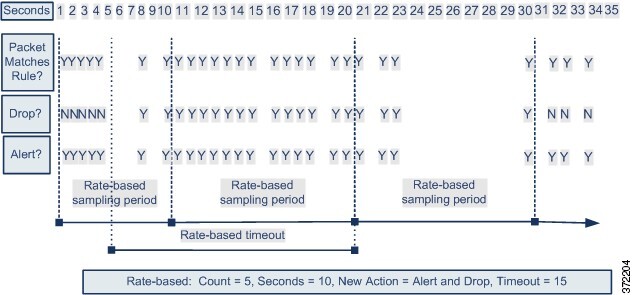Understanding Intrusion Prevention Rule Types
License: Protection
An intrusion policy contains two types of rules: intrusion rules and preprocessor rules.
An intrusion rule is a specified set of keywords and arguments that detects attempts to exploit vulnerabilities on your network; an intrusion rule analyzes network traffic to check if it matches the criteria in the rule. The system compares packets against the conditions specified in each rule and, if the packet data matches all the conditions specified in a rule, the rule triggers. The system includes two types of intrusion rules created by the Cisco Vulnerability Research Team (VRT): shared object rules, which are compiled and cannot be modified (except for rule header information such as source and destination ports and IP addresses), and standard text rules, which can be saved and modified as new custom instances of the rule.
The system also includes preprocessor rules, which are rules associated with preprocessor and packet decoder detection options. You cannot copy or edit preprocessor rules. Most preprocessor rules are disabled by default and must be enabled (that is, set to Generate Events or to Drop and Generate Events) if you want the system to generate events for preprocessor rules and, in an inline deployment, drop offending packets.
The VRT determines the default rule states of Cisco’s shared object rules, standard text rules, and preprocessor rules for each default intrusion policy included with the system.
The following table describes each type of rule included with the ASA FirePOWER module.
|
Type |
Description |
|---|---|
|
shared object rule |
An intrusion rule created by the Cisco Vulnerability Research Team (VRT) that is delivered as a binary module compiled from C source code. You can use shared object rules to detect attacks in ways that standard text rules cannot. You cannot modify the rule keywords and arguments in a shared object rule; you are limited to either modifying variables used in the rule, or modifying aspects such as the source and destination ports and IP addresses and saving a new instance of the rule as a custom shared object rule. A shared object rule has a GID (generator ID) of 3. |
|
standard text rule |
An intrusion rule either created by the VRT, copied and saved as a new custom rule, created using the rule editor, or imported as a local rule that you create on a local machine and import. You cannot modify the rule keywords and arguments in a standard rule created by the VRT; you are limited to either modifying variables used in the rule, or modifying aspects such as the source and destination ports and IP addresses and saving a new instance of the rule as a custom standard text rule. See Importing Local Rule Filesfor more information. A standard text rule created by the VRT has a GID (generator ID) of 1. Custom standard text rules that you create using the rule editor or import as local rules have a SID (Signature ID) of 1000000 or greater. |
|
preprocessor rule |
A rule associated with a detection option of the packet decoder or with one of the preprocessors included with the ASA FirePOWER module. You must enable preprocessor rules if you want them to generate events. These rules have a decoder- or preprocessor-specific GID (generator ID). |
 as the
as the  >
>





 ) next to the policy you want to edit.
) next to the policy you want to edit.
 or down
or down  arrow on a heading or icon indicates that the sort is on that column in that direction.
arrow on a heading or icon indicates that the sort is on that column in that direction.
 ) appears in a field when you type an invalid value; click it to revert to the last valid value for that field or to clear
the field if there was no previous value.
) appears in a field when you type an invalid value; click it to revert to the last valid value for that field or to clear
the field if there was no previous value.
 .
.


 ) appears in a field when you type an invalid value; click it to revert to the last valid value for that field or to clear
the field if there was no previous value.
) appears in a field when you type an invalid value; click it to revert to the last valid value for that field or to clear
the field if there was no previous value.

 Feedback
Feedback